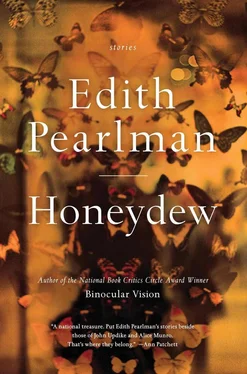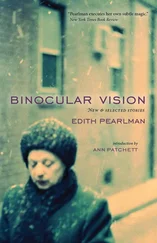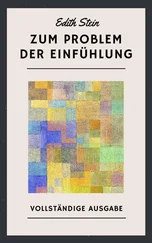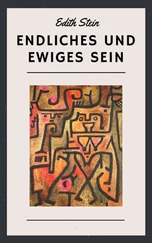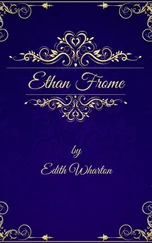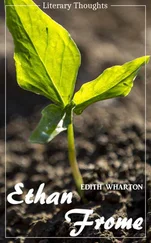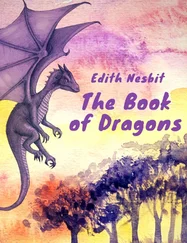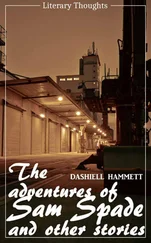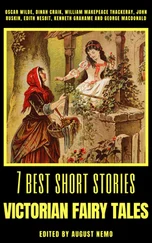“You could show it to that ass of an editor,” I said to Toby.
“I will show it to Mr. Jennings.”
She did. And Mr. Jennings, not questioning provenance or authenticity or age, accepted the coin on behalf of the historical society with the grace of a vanquished lover. He provided a display case on legs, and a card which read ROMAN COIN C. 400 A.D. Somebody snapped a color photograph for the Piscataqua weekly — Mr. Jennings, Toby, me, Uncle Franz, all but one of us looking down at the coin. And then I saw what I had already known without knowing I knew it: I might have Aunt Toby’s hair and chin, but I had Uncle Franz’s cylindrical brow and chocolate eyes, those eyes that preferred to look at me rather than the coin, though I don’t think he was ashamed of either of us.
I had long considered the train-wreck death that Toby had supplied for my vague father and mother unworthy of her imagination.
Uncle Franz (I will always call him that) sold his shop and said good-bye to New York. He moved in with us. Toby gave up fictohistoriographia and turned to writing adventure books, frankly invented. So she never told of the heroism of a mother who let go of her child to save him. And she never revealed the story of a woman of forty and a man considerably older who briefly combined in order to perpetuate a Hungarian family, their secret connivance encouraged by another heroine, one who would have performed the task herself but could not.
And I, my provenance acknowledged at last, my parents together at last, went off to seek my own fortune, as Toby’s children are destined to do.
I.
Lyle stares at a lemon.
How does the lemon appear to Lyle? The rough skin is what he has been taught to call yellow, and he knows many modifiers of that word — pale, bright, dull; he knows also metaphoric substitutes — gold, butter, dandelion, even lemon. What he sees in the humble fruit, though, and what he knows by now other kids don’t see, is a tangle of hundreds of shades, ribbons of sunlight crushed into an egg.
And baby oil? His mother, Pansy, works baby oil into her pale satin face and neck before going to bed, and a drop inevitably spills from her fingertip: transparent, translucent, colorless, or so anybody else would say. To Lyle, however, the drop is a rosy viscous sphere. The shade of his skin — caramel or butterscotch or café au lait according to foodies, mulatto to those interested in mixed races — incorporates movement too: on his forearm writhe all the hues in Pansy’s drawer of muddled lingerie.
And the neon sign projecting from the exercise center on the second floor of a building in Godolphin Square? Neon plasma has the most intense light discharge of all the noble gases. To a normal human eye it is red-orange; it also contains a strong green line hidden unless you’ve got a spectroscope. Lyle sees the green line unaided, the flowing molecules of it. It is as if the sign, GET FIT, has given him a gift.
But then, Lyle has been given many gifts, including Pansy’s love. Bathed in that love, Lyle in turn is gentle with other kids, especially with kids uneasy under their bragging, kids really as frightened as rabbits when a hawk darkens their world. Lyle’s underweight presence steadies them, and he is sought after — but not exactly as a friend. He is more like Anansi, the helpful spider of his favorite tales — a quiet ally and trickster who prefers his own company but skitters over to join you when you need him.
Yet another gift is money. These days, money resides in electronic bits; Pansy has plenty of bits inherited from her Alabama grandfather. And there is, or was once, the gift of a small amount of yellowish fluid containing enzymes, acids, and lipids. Semen, not to put too fine a point on it.
The unknown bestower of the semen had been living on the edge. He’d come from Africa in a troop of lost boys — not the famous ones from Sudan but less famous, less numerous ones from elsewhere. But the situation was similar: civil war, carnage, a few boys running from their ruined villages all the way to the United States.
One particular lost boy ended up in Massachusetts, lived in a house with other lost boys, got through high school, and at the time of his gift was employed in a lab in the area. But he was poor. And so he did what many people in his situation did: sold his blood. He thought about selling his sperm too, but he considered it too valuable to be made a commodity — he was proud and he was free and he wanted freely to sire a thousand American sons. So he did not sell but gave his sperm to a bank — really a hospital roomlet provided with facilitating magazines.
II.
And then there’s a submicroscopic gift, the consequence of a genetic mutation that has passed mostly unexpressed through the millennia. It was bestowed by evolution not directly on Lyle but on a primate who was his remote ancestor. The gift was a mischievous gene, which, if it meets its twin, can affect vision.
“Primate vision unadulterated is trichromatic,” said Dr. Marcus Paul. “ Tri means ‘three,’ and chroma means ‘color.’”
“Yes?” Pansy encouraged from the other side of the desk.
“Well, Mrs. Spaulding—”
“Miss.”
“Miss…”
“Or Ms., if you want to be correct.” She grinned.
“Ms., then,” the flustered man said, and took refuge in a disquisition. “You know the retina, at the back of the eye, the thing that captures light and color and ships them to the brain. The retina uses only three types of light-absorbing pigments for color vision. Trichromacy, see?”
“See,” she agreed, still grinning.
“Well, almost all nonprimate mammals are dichromatic, with just two kinds of visual pigments. A few nocturnal mammals have only one pigment. But some birds, fish, and reptiles, they have four.”
“They see more colors than we do? Damn it all.”
“They probably do. And some butterflies are even pentachromatic. Pigeons also. And there is one twig on the Homo sapiens tree whose members — a small fraction of them — are believed to be pentachromatic too: the Himba tribe. Himbas endure their usually short lives in Namibia…Lyle seems to be of mixed race.”
“Yes. I asked the sperm bank for a black donor. I believe miscegenation is an answer to the world’s ills. All people one color: tan.”
“Oh,” said the doctor, whose skin was the shade of eggplant. “Your donor was African?”
She shrugged her slender shoulders. “I didn’t ask, and they didn’t tell.”
“Well, I think Lyle’s a pentachromat. Those colors he reports.”
She nodded. She was all at once serious. “Yes. No wonder he has headaches, my poor boy.” Then she paused, partly to let this young Jamaican take a frank look at her, as he was clearly eager to do — at her inky curls, at her small straight nose that angled upward a degree more than is usual, robbing her of beauty and instead making her irresistible; physiognomy’s gift to Pansy, you might say. The doctor could see also her wide mouth, her dimples, her long neck and long hands. Her long legs were hidden from him by his desk, but he must have noticed them earlier. She hoped so. Oh, yes, and when she parted her lips, out flashed the bright white of her perfect incisors. Men often remarked on that…She continued now: “What’s it like to be a pentachromat?” Though she knew, or had an idea; Lyle had told her of the numerous dots of color he could detect on a plain manila envelope. She had taught him a new word: pointillism . “Doctor?”
What’s it like to have a face like yours? He said: “Neither we nor they have the words to describe this sort of thing. How would you describe color to someone who was color-blind? What we do know is that tetrachromats and pentachromats make distinctions between shades that seem identical to the rest of us. For example, I read about a woman in California, she’s dead now—”
Читать дальше
